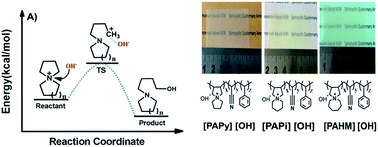Spirocyclic quaternary ammonium cations for alkaline anion exchange membrane applications: an experimental and theoretical study†
Abstract
Spirocyclic quaternary ammonium (QA) cation based anion exchange membranes (AEMs) were prepared and studied by both experimental measurements and theoretical calculations. Spirocyclic QA cations, including 5-azoniaspiro[4.4]nonane ([ASN]+), 5-azoniaspiro[4.5]decane ([ASD]+), and 5-azoniaspiro[4.6]undecane ([ASU]+) were synthesized as small molecule model compounds and investigated in terms of their chemical stability in alkaline media at elevated temperatures. Compared with nonspirocyclic QA cations, spirocyclic QAs possessed higher alkaline stability, which correlates with their higher energy barrier value associated with a transition state. Furthermore, analogous spirocyclic QA cation based AEMs with promising alkaline stability in alkaline medium were synthesized via photo-cross-linking. The results indicated that alkaline stability studies on small molecule cations may provide a basis for evaluating that in corresponding polymer membranes, and also inspired a feasible way for the preparation of alkaline stable AEMs.



 Please wait while we load your content...
Please wait while we load your content...